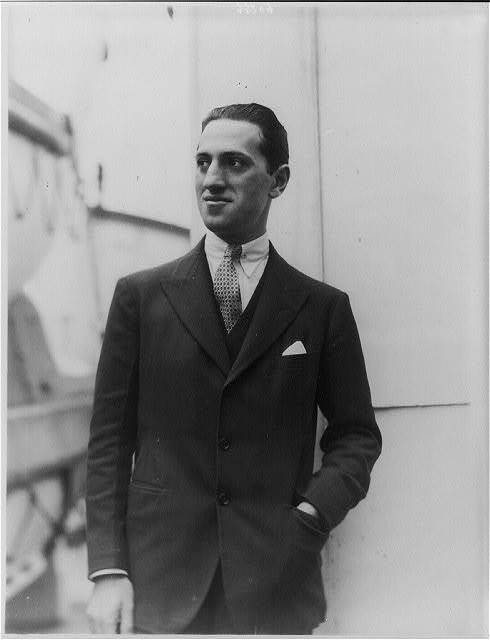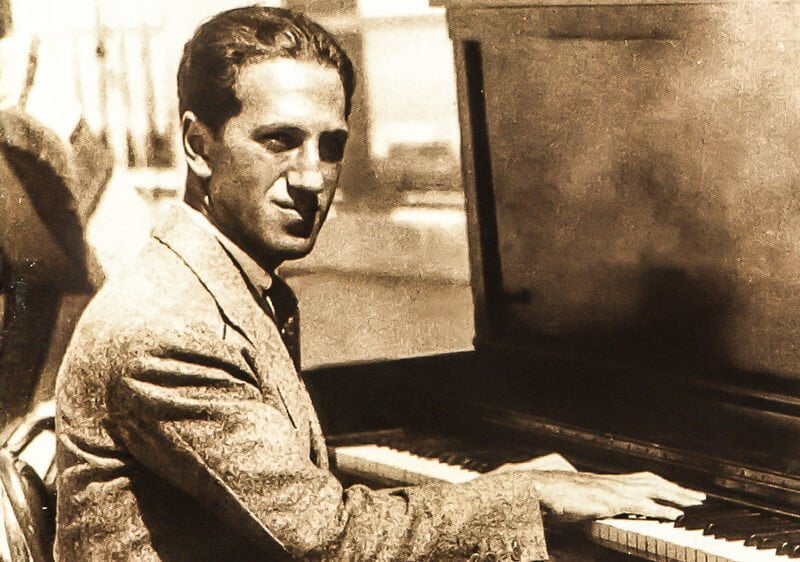George Gershwin (1898-1937)
Despite George Gershwin’s humble beginnings and short life (he died at the age of 38), he became one of the most famous and successful American composers of all time, and his music is still extremely popular and played all over the world. Though he started his career as a popular jazz composer, he ended up writing musicals and operas, film music, and pieces for classical ensembles too.
His parents were Russian Jewish immigrants who came to the United States in the 1890s. He spent his boyhood running around in New York with his friends, and it wasn’t until he was 10 that he showed any interest in music. He took to the piano (his parents had bought one for his brother Ira) and he must have been pretty good because at 15 he left school and became a song plugger in Tin Pan Alley. He worked in a shop, and if a customer was interested in buying the sheet music for a song, the music would be sent to the song plugger who sat at the piano in the middle of the store. The song plugger played the song so the customer could get a preview of the piece before they bought it.

Soon Gershwin was writing songs, and in 1919 his song ‘Swanee’ was performed by the famous singer Al Jolson. From that point there was no stopping him – he wrote musicals and songs, and then jazz-influenced classical pieces for orchestra (including ‘Rhapsody in Blue’). In 1935 he wrote the opera Porgy and Bess, which includes the really famous song ‘Summertime’, which you can listen to below.
Gershwin was interested in contemporary musical developments, and wrote to various composers to ask to study with them. One of those composers was Arnold Schoenberg, who wrote very modern, dissonant music. Schoenberg replied: “I would only make you a bad Schoenberg, and you’re such a good Gershwin already”. Gershwin asked the same question of the French composer Maurice Ravel, who, when he heard how much money Gershwin made, said, “You should give me lessons.”
Rhapsody in Blue (1924)
In 1924 Gershwin was asked by bandleader Paul Whiteman to write a piece for an experimental orchestral concert which fused jazz and classical elements. Gershwin was very busy, and refused. However, Whiteman ignored this (or forgot) and published an advert for the concert which included the announcement that there would be a new piece by Gershwin. Gershwin was confused by this, having turned down the commission, but Whiteman convinced him to write the piece anyway, which Gershwin did – finishing it in only 5 weeks.
The piece is for solo piano and orchestra, and initially Gershwin didn’t write down the piano part. He was the soloist in the first performance and simply played it from memory, or improvised it. It was only later that he wrote it down for other pianists to play.
The piece’s opening is really famous, with a clarinet slide to a high note. This was improvised by the clarinettist in the first rehearsal and Gershwin liked it so much that he put it in the piece.
Rhapsody in Blue lasts just over 15 minutes, and features lots of piano cadenzas. These are moments where the orchestra stops and the piano plays a virtuosic solo, showing just how accomplished the pianist is. The piece also has lots of jazzy elements: jazzy rhythms and melodies, as well as instruments such as saxophones and a banjo.
The piece has been described as a musical picture of New York, so when you listen to it, see what pictures come to your mind – there’s no right or wrong. Perhaps the opening clarinet solo is a big musical yawn – getting up in the morning ready to walk around New York.
Whatever pictures it creates in your mind, this piece is full of jazzy energy, some wonderful tunes and great piano playing. Enjoy it!
